We discovered the secrets and history of that quintessential New Orleans dish by sampling it over and over at some of the city’s leading gumbo purveyors.
Published Mar 14, 2024 • Last updated 14 hours ago • 7 minute read
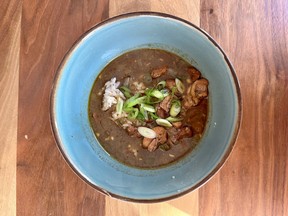 Gumbo made during a Mardi Gras School of Cooking class in New Orleans. Photo by Peter Hum /POSTMEDIA
Gumbo made during a Mardi Gras School of Cooking class in New Orleans. Photo by Peter Hum /POSTMEDIA
NEW ORLEANS, Louisiana — In Alexis Ruiz’s family, developing gumbo expertise starts young.
Her eight-year-old daughter, Juliette, pays close attention when her father, chef Richard Ruiz, makes his version of that quintessential New Orleans dish at an eatery called the Munch Factory.
Article content
“She understands the roux, that there’s this odd, burnt-popcorn smell. That’s the moment when you know it’s ready,” says Ruiz, the Munch Factory’s co-owner.
Advertisement 2
This advertisement has not loaded yet, but your article continues below.
THIS CONTENT IS RESERVED FOR SUBSCRIBERS ONLY
Subscribe now to read the latest news in your city and across Canada.
Exclusive articles from Elizabeth Payne, David Pugliese, Andrew Duffy, Bruce Deachman and others. Plus, food reviews and event listings in the weekly newsletter, Ottawa, Out of Office.Unlimited online access to Ottawa Citizen and 15 news sites with one account.Ottawa Citizen ePaper, an electronic replica of the print edition to view on any device, share and comment on.Daily puzzles, including the New York Times Crossword.Support local journalism.
SUBSCRIBE TO UNLOCK MORE ARTICLES
Subscribe now to read the latest news in your city and across Canada.
Exclusive articles from Elizabeth Payne, David Pugliese, Andrew Duffy, Bruce Deachman and others. Plus, food reviews and event listings in the weekly newsletter, Ottawa, Out of Office.Unlimited online access to Ottawa Citizen and 15 news sites with one account.Ottawa Citizen ePaper, an electronic replica of the print edition to view on any device, share and comment on.Daily puzzles, including the New York Times Crossword.Support local journalism.
REGISTER / SIGN IN TO UNLOCK MORE ARTICLES
Create an account or sign in to continue with your reading experience.
Access articles from across Canada with one account.Share your thoughts and join the conversation in the comments.Enjoy additional articles per month.Get email updates from your favourite authors.
Sign In or Create an Account
or
Article content
If Juliette masters making her father’s gumbo, a culinary triumph will live on. Among one of many gumbos that we sampled during our recent New Orleans vacation, the Munch Factory’s gumbo, as dark and nutty as you could imagine and teeming with not only slices of sausage and chunks of ham, but also plump shrimp and a seam of seafood flavour in its broth, was unsurpassed.
My fellow travellers and I ate various gumbos at every opportunity. They ranged from enjoyable to delicious whether they featured chicken or duck or sausage or ham or exclusively seafood, whether they were topped with rice or a devilled egg, whether they were thickened with the addition of okra or of file (ground sassafras) powder, or whether, in two outlying cases, alligator or quail starred in the bowl.
Gumbo, Ruiz says, is “the one dish that can have every type of interpretation.” However, she and other New Orleanians frown on putting tomatoes in gumbo, which strikes them as flagrantly inauthentic.
Food scholars say today’s gumbos can be traced back to early 18th-century Louisiana. By the mid-1700s, Africans in New Orleans were mixing okra, known as ki ngumbo in their mother tongue, with rice. But, because New Orleans is a melting-pot city that saw waves of French and Spanish settlement, not to mention the influence of nearby Cajuns (displaced Acadians from the Canadian Maritimes), gumbo developed into a multicultural mishmash, improved by all its influences.
Advertisement 3
This advertisement has not loaded yet, but your article continues below.
Article content
Gumbo “is like our country, our world. All these different people are coming together and we’re
meshing in that velvety roux and we’re making one heck of a dish and that’s fascinating,” says chef Edward “Dook” Chase IV, who served us fantastic gumbo at his restaurant Chapter IV.
Gumbo is in Chase’s blood. His grandmother, the late Leah Chase, was a queen of Creole cuisine in New Orleans. Decades ago, she served gumbo to civil rights leaders and freedom riders, both black and white, when they met at her famous Dooky Chase Restaurant, even though integrated dining was illegal.
“We were open for all the community,” Chase says. “My grandmother had a saying: She helped change the course of America over a bowl of gumbo.”
The question every gumbo-maker must confront is how dark to take their roux, a combination of vegetable oil and flour that darkens as the flour cooks. Yes, a darker roux grows intoxicatingly more nutty in smell and flavour. But the risk always looms of burnt roux, which must be trashed before starting the gumbo again.
Alexis Ruiz says her husband’s roux brinksmanship makes her nervous. “I’m like, ‘You’re burning it,’ and he’s like, ‘Get out of here, nobody’s burning it, I know what I’m doing,’” she says with a laugh.
Advertisement 4
This advertisement has not loaded yet, but your article continues below.
Article content
Nate Prendergast, a guide with Doctor Gumbo Tours who leads culinary tours in New Orleans, says the gumbo he makes each Christmas Eve takes 52 minutes of stirring to get its roux right.
“I go low, I go slow, I go super-dark. I call it a three-beer gumbo,” Prendergast says. The roux is ready, he says, when he can smell roasted almonds and the roux is the colour of a “heavily tarnished copper penny.”
Chase says his gumbo at Chapter IV is not as dark as the gumbo that Louisiana’s Cajuns make, because the distinct flavours of his chosen proteins — chaurice and andouille sausages, crab, shrimp, chicken — shine better if the roux is a shade lighter.
“It all depends on your preference,” he says. “They’re all great gumbos.”
During our final afternoon in New Orleans, Cam Holmes, a chef-instructor at the Mardi Gras School of Cooking, taught us to make a very tasty gumbo, even if we took a shortcut with store-made broth.
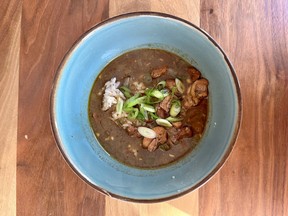 Gumbo made during a Mardi Gras School of Cooking class in New Orleans. Photo by Peter Hum /POSTMEDIA
Gumbo made during a Mardi Gras School of Cooking class in New Orleans. Photo by Peter Hum /POSTMEDIA
We got the hang of making the roux and took home the pro tip that bits of roux stuck to the bottom of the pot can come unstuck before they burn if you take the pot off the heat and scrape, or lower the heat and scrape.
Advertisement 5
This advertisement has not loaded yet, but your article continues below.
Article content
 From left to right, Alex Boudreau and Pascal Hum learn the finer points of making gumbo from chef Cam Holmes of the Mardi Gras School of Cooking in New Orleans. Photo by Peter Hum /POSTMEDIA
From left to right, Alex Boudreau and Pascal Hum learn the finer points of making gumbo from chef Cam Holmes of the Mardi Gras School of Cooking in New Orleans. Photo by Peter Hum /POSTMEDIA
We made smaller portions of gumbo, even if that contravened the gumbo code.
“I tell people there’s no possible way to cook a small pot of gumbo,” chef Chase says. “You have to be bringing people together to eat at the table, for celebrations, for friendships, for whatever.”
Munch Factory Gumbo
Note: This recipe yields leftovers, but gumbo tastes better reheated the next day. The recipe could easily be halved or even quartered.
Makes: about 2.5 gallons of gumbo, or more than 20 12-oz (590 mL) servings
4 cups (1 L) vegetable or canola oil, divided
3 cups (750 mL) all-purpose flour
6 cups (1.5 L) chopped onions
3 cups (750 mL) celery, chopped
3 cups (750 mL) green bell peppers, chopped
1/2 cup (125 mL) garlic, finely chopped
2 gallons shrimp or crab stock (cold)
1 tbsp (15 mL) hot sauce
Salt and black pepper
12 gumbo crabs (Louisiana blue crabs)
12 bay leaves
1/4 cup (60 mL) fresh or dry thyme
9 andouille or smoked sausage links (cut into half-moon slices)
2 lbs (907 g) ham (cut in 1-inch/2.5 cm cubes)
1 cup (250 mL) green onions, chopped
1 cup (250 mL) coarsely chopped parsley
1 lb (454 g) large shrimp, peeled
1/2 lb (226 g) oysters, freshly shucked
1 tsp (5 mL) creole seasoning, or to taste
1/2 cup (125 mL) file powder
Advertisement 6
This advertisement has not loaded yet, but your article continues below.
Article content
Make a dark roux: Heat 3 cups oil in a large soup pot over high heat. When oil begins to smoke, whisk in flour. Continue to whisk constantly until mixture is a rich brown colour. Be careful not to produce specks of black. Roux must remain an even colour throughout the process. If specks appear, you must start over. When roux is mahogany-coloured, pour in the cold stock and whisk.While the gumbo comes to temperature, in a large sauté pan, heat remaining 1 cup (250 mL) of vegetable oil. When the pan gets smoking hot, add the sausage and ham. Cook until slightly browned and then add the onions, celery, bell peppers, and garlic. Cook until the vegetables are softened. Add the sausage and vegetable mix to the gumbo base. Once the gumbo comes back to a boil, add the crabs, thyme, bay leaves, hot sauce, salt and pepper. Simmer for 1 hour and skim off the majority of the oil that rises to the top.Stir in the green onions, parsley, shrimp, oysters and creole seasoning. Cook 15 to 20 minutes longer. Stir in the file powder. Taste and adjust seasoning if necessary.
Five stops on a gumbo tour of New Orleans
Advertisement 7
This advertisement has not loaded yet, but your article continues below.
Article content
The Munch Factory
6514 Congress Dr, New Orleans, themunchfactory.net
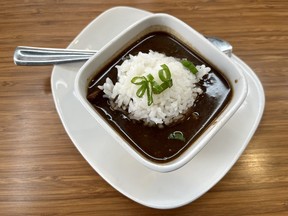 Seafood and andouille and hot sausage gumbo at the Munch Factory in New Orleans. Photo by Peter Hum /POSTMEDIA
Seafood and andouille and hot sausage gumbo at the Munch Factory in New Orleans. Photo by Peter Hum /POSTMEDIA
This family-run restaurant makes a craveworthy seafood and andouille and hot sausage, teeming with complex flavours and the nuttiness of an exceptionally dark and earthy roux from a chef unafraid of pushing that sublime combination of oil and flour to its flavourful maximum. The Munch Factory’s roast beef nachos and blackened fish with fried grit cakes and crayfish sauce are also to die for.
Chapter IV
1301 Gravier St., New Orleans, chapterivnola.com
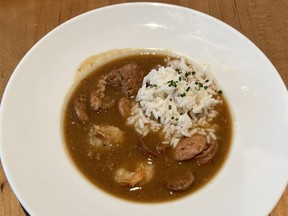 Creole gumbo at Chapter IV in New Orleans. Photo by Peter Hum /POSTMEDIA
Creole gumbo at Chapter IV in New Orleans. Photo by Peter Hum /POSTMEDIA
At his downtown breakfast-and-lunch eatery, the gumbo was fine and balanced, as you would expect from a chef, Edgar “Dook” Chase IV, who is the grandson of the fabled New Orleans chef Leah Chase. We also swooned over indulgently rich oysters Rockefeller and shrimp with the creamiest grits imaginable.
Red Fish Grill
115 Bourbon St., New Orleans, redfishgrill.com
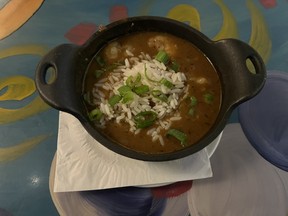 Alligator sausage and seafood gumbo at Red Fish Grill in New Orleans. Photo by Peter Hum /POSTMEDIA
Alligator sausage and seafood gumbo at Red Fish Grill in New Orleans. Photo by Peter Hum /POSTMEDIA
On hyper-touristy Bourbon Street and in the French Quarter in general, gumbo can be hit and miss. At Red Fish Grill, part of the well-regarded Ralph Brennan Restaurant Group, the gumbo hit all the right notes, and its sausage contained the very Cajun addition of alligator. Red Fish Grill was also the first stop during our recent Doctor Gumbo Tours food tour of the French Quarter.
Cochon
930 Tchoupitoulas St., New Orleans cochonrestaurant.com
Advertisement 8
This advertisement has not loaded yet, but your article continues below.
Article content
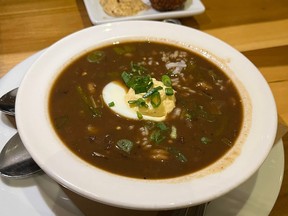 Cajun seafood and devilled egg gumbo at Cochon in New Orleans. Photo by Peter Hum /POSTMEDIA
Cajun seafood and devilled egg gumbo at Cochon in New Orleans. Photo by Peter Hum /POSTMEDIA
At this upscale Cajun restaurant that part of the estimable Link Restaurant Group, the gumbo comes highly seasoned and with a devilled egg sitting pretty in its centre.
Li’l Dizzy’s Cafe
1500 Esplanade Ave., New Orleans, lildizzyscafe.net
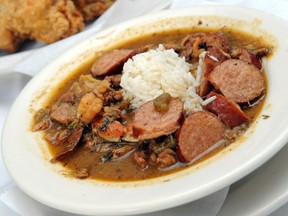 Gumbo at Ll’l Dizzy’s Cafe in New Orleans. Photo by Cheryl Gerber
Gumbo at Ll’l Dizzy’s Cafe in New Orleans. Photo by Cheryl Gerber
The chunkiest, most rib-sticking gumbo that we chanced upon in New Orleans was at Li’l Dizzy’s Cafe, a revered soul-food cafe in the historic Treme neighbourhood.
Peter Hum’s stay in New Orleans was partially supported by New Orleans & Company, the city’s convention and visitors’ bureau.
Recommended from Editorial

Hum: An all-Asian vacation in San Francisco offered as much stellar Asian food as I could fit into four days. It was bliss

Peter Hum’s favourite Ottawa restaurant dishes in 2023
Article content
>>> Read full article>>>
Copyright for syndicated content belongs to the linked Source : OttawaCitizen – https://ottawacitizen.com/life/food/gumbo






























